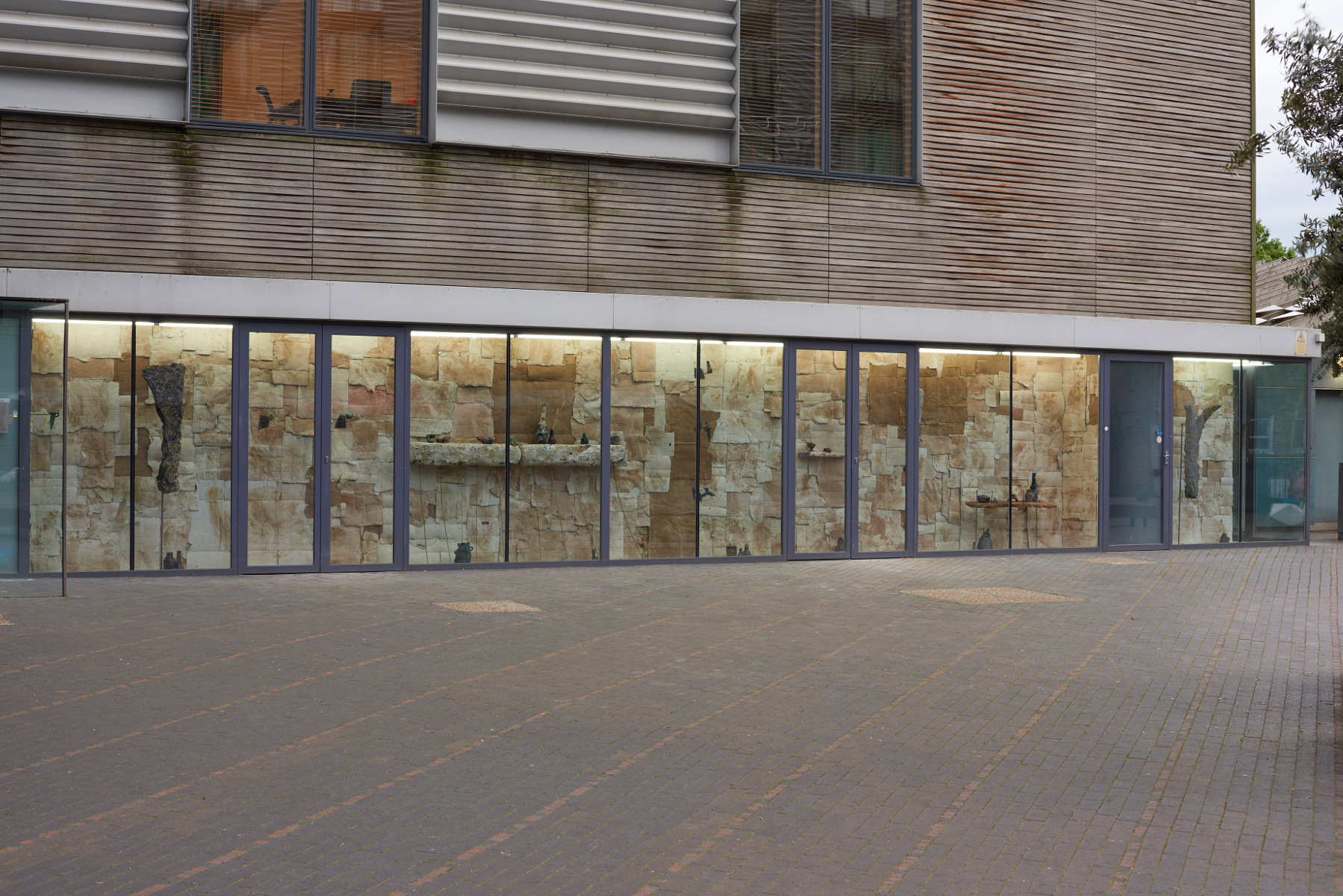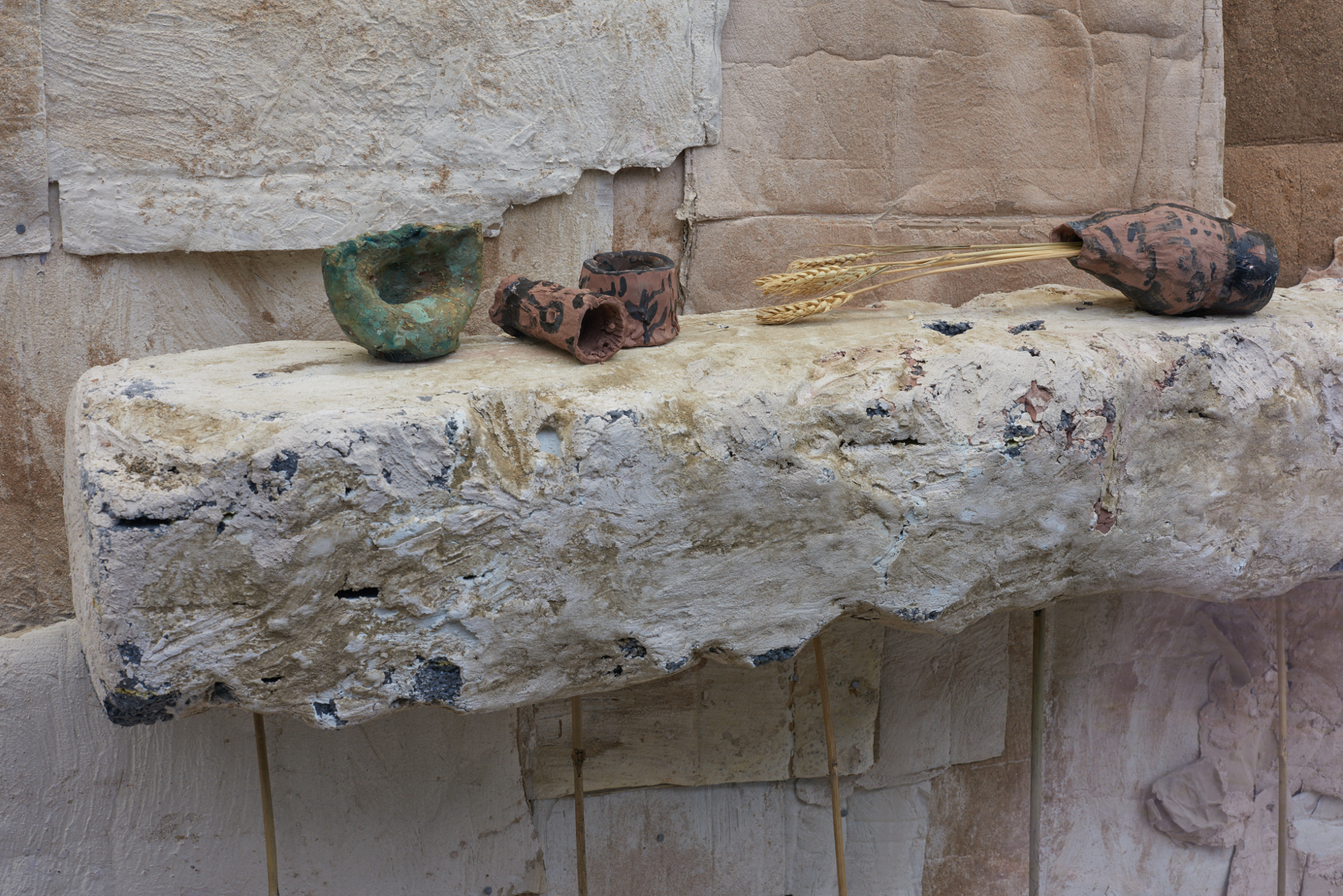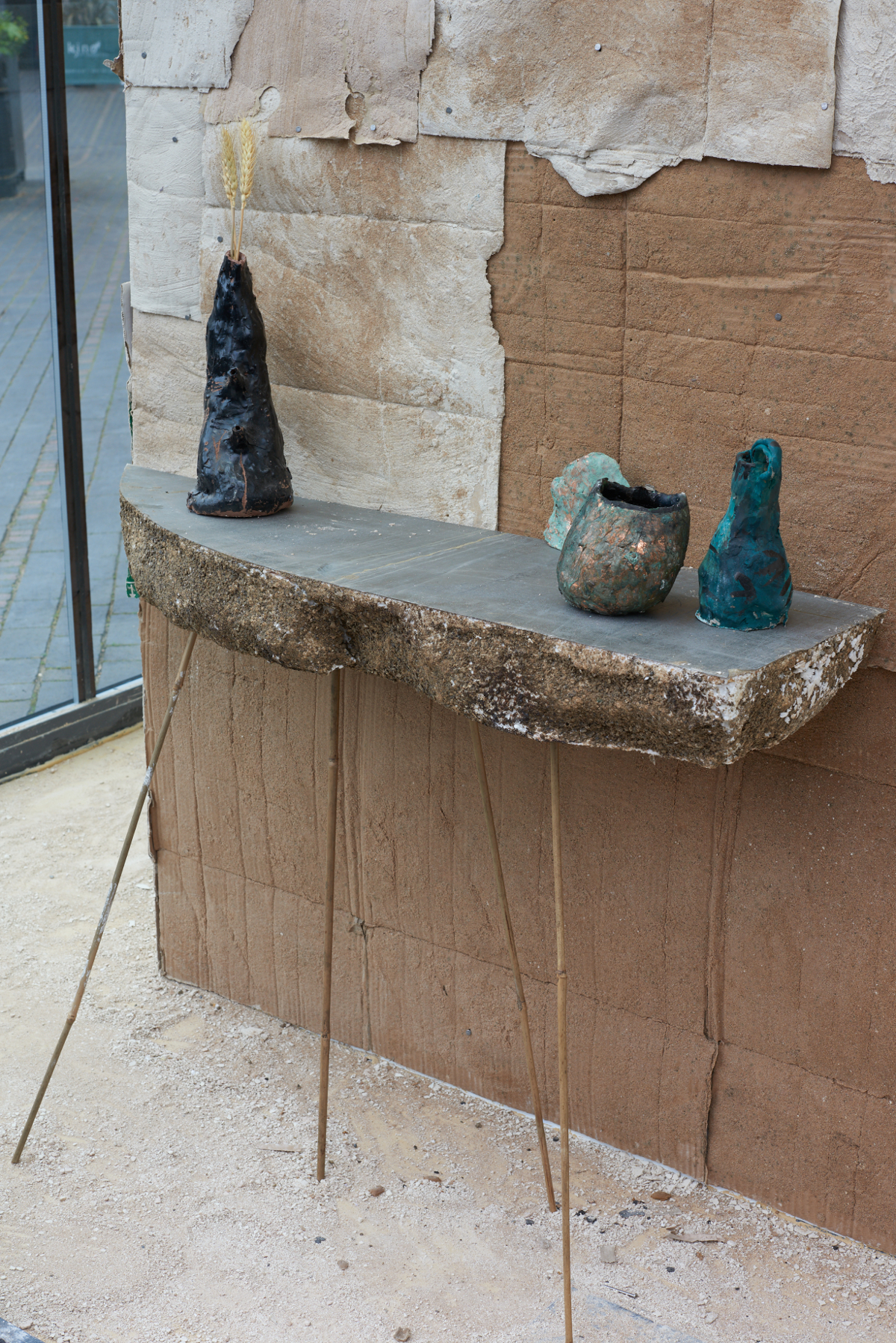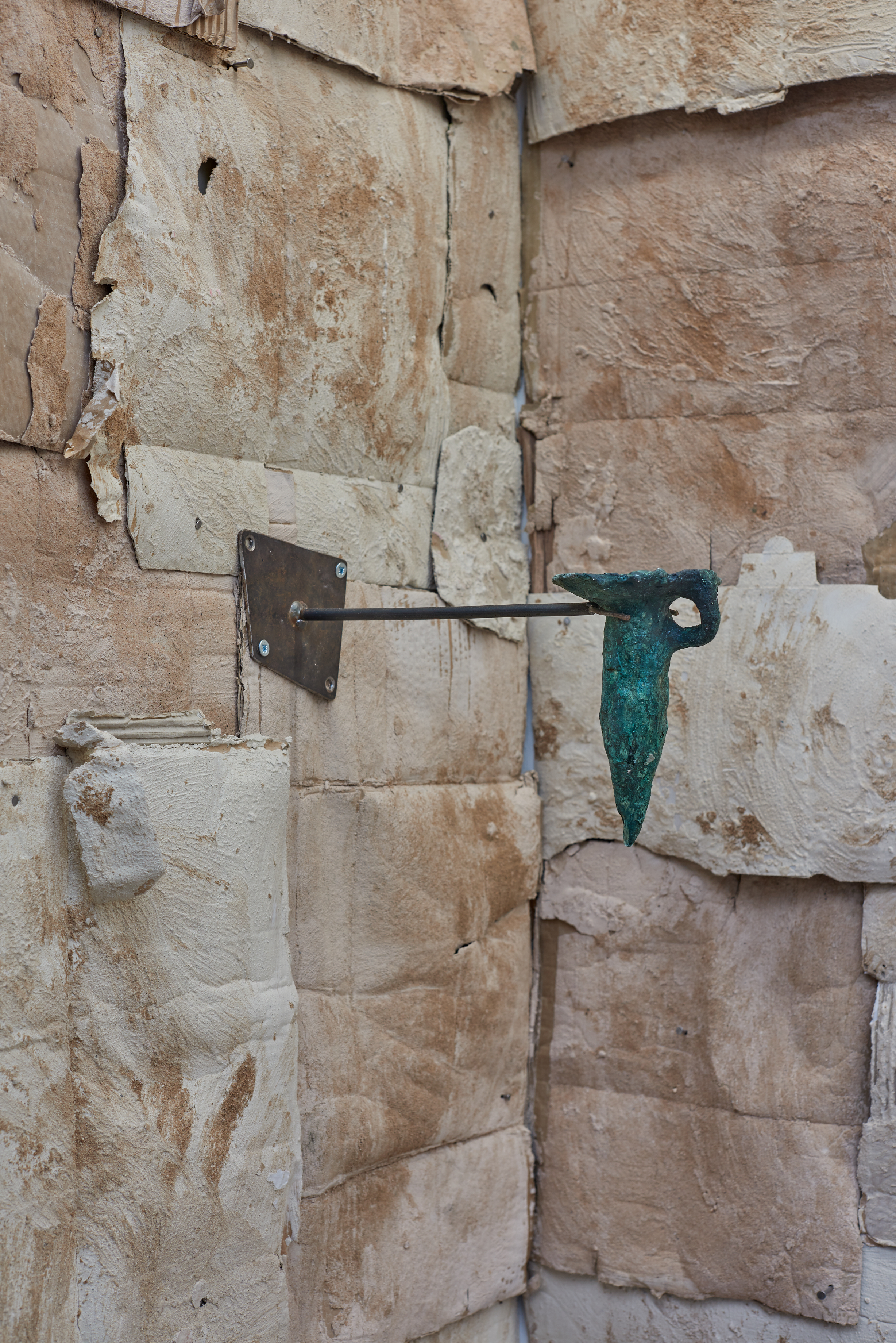Emii Alrai
Interview by William Noel Clarke
-
Published September 2019
-
Emii Alrai in conversation with William Noel Clarke about her show Tutelaries at VITRINE, London.
-

Tutelaries, 2019. Installation view. VITRINE, London. Images courtesy of VITRINE. Photographer Jonathon Bassett
To begin with, maybe you could explain where the title of your show Tutelaries came from and its relationship to your practice?
I came across the term Tutelaries in a book written by Leonard Woolley. He was one of the first excavators of the ancient site of Ur and Nimrud, areas where the Ancient Middle Eastern Civilisations were active. A tutelary is an object which serves as a protector or guardian which are often found in grave sites, or holy and pilgrim places where objects are strategically placed to ward off evil spirits. My practice focuses on the appropriation and display of objects in western museums so I became interested in the term Tutelaries, particularly in relationship to VITRINE’s space; a literal display case similar to those which museums use so that the public cannot touch or get close to the objects. I wanted to explore how the sculptural objects I made could act as 'guardians' or 'ritual depositories' in the space.
The objects I make look like ancient artefacts, replicating bronzes and fragments from archaeological digs. I'm interested in how these objects hold value despite them being forgeries, made from materials such as clay and plaster which is then patinated. While working toward the show at VITRINE, I wanted to make new work and merge it with vessels and shapes from previous shows, and in seeing these objects come together reminded me of diagrams of tutelary vessels, sad protectors which guard spaces which often have been looted, or demolished.

Tutelaries, 2019. Installation view. VITRINE, London. Images courtesy of VITRINE. Photographer Jonathon Bassett
So, has working in VITRINE's space, a glass fronted gallery on a public square viewable 24/7, changed your relationship to the work? Did you feel like you engaged with your work and practice differently than in a normal white wall gallery?
Yes, to an extent. I wanted to fill the space as much as possible to change it from a white walled space. I found the format of the space challenging as it looks different from every angle of the square, and I wanted the space to have a sense of a continued narrative, despite the fragmentary nature of the work. Making the panels to cover the walls was a decision taken to allow a sense of continuity from all different viewpoints, but it also becomes a backdrop to the objects on display. I think for this particular project at VITRINE, I had to think about the work on a larger scale and it being responsive somehow to the location of Bermondsey Square, or the reverse of it being extremely dense and alien to the space, similarly to how museums display objects.

Tutelaries, 2019. VITRINE, London. Images courtesy of VITRINE. Photographer Jonathon Bassett
It also gives the space more depth through its texture.
I think so! I made a similar wall covering at a show called An Ancient Quiver last year at GLOAM Gallery in Sheffield and it had the same effect of transforming the space. I was quite interested in how that would work in the challenging space at VITRINE. I think the covering not only gives depth from afar, but also changes its form. A lot of people who have visited have commented on how they thought it was stone at first glance. I’m really intrigued by the ability of the material to forge itself different identities from different vantage points.

Tutelaries, 2019. Installation view. VITRINE, London. Images courtesy of VITRINE. Photographer Jonathon Bassett
Tutelaries, as you have described, are real objects bestowed with spirituality. Have you researched and handled these objects in real life, at museums or in other places?
Absolutely! Until quite recently I had mainly conducted my research through reading. I am quite obsessive about research time, usually dedicating a few months of working outside of the studio to read, reference and write. For this project, I was mostly using archaeological surveys and research papers written by archaeologists on the field, as well as cross referencing shrine sites and museum displays I’ve had the privilege to visit, such as the Coptic Shrines and the British Museum. This year has been unexpectedly lucky as I was nominated for a project with the Arab British Centre for an exchange to Kuwait, getting to spend time in the collections of the Amricani Cultural Centre as well as getting to learn about Kuwait and its relationship to its own identity.
Recently, I visited the Ashmolean as part of my participation in the Tetley Artist Associate programme. We met with their curator of Ancient Near East in their department of Antiquities, that was amazing. I was able to handle various objects that have been considered tutelary historiographies. It’s interesting, there are so many artefacts from the area - Ancient Near East - but very little documentation about their daily uses in cuneiform, so many of the artefacts and forms which are considered tutelic, are guessed. I’m interested in the relationship of manufacturing the histories civilisations and languages, and then placing this on objects, particularly tutelaries. Collections are such an under-utilised resource, and free to access!

Tutelaries, 2019. Installation view. VITRINE, London. Images courtesy of VITRINE. Photographer Jonathon Bassett
Would you be interested in participating in archaeological digs, particularly in Iraq or the Middle East?
Yes! I’m not sure how useful I would be but it would be something I would love to do or to observe. I would love to do digs in Iraq and learn from the amazing teams which are conserving and redefining Iraq’s heritage. I would equally love to do any archaeological digs in the U.K., maybe in Scotland. I did try to join a metal detectorist group in Leeds, but there was a 3-year waiting list. If you are reading this pls can I join...

What’s next after your show at VITRINE?
I’m working on a few projects which will take me up to about March next year. To close the show at VITRINE, I will be doing an ‘in-conversation’ with writer James Harkin, who has written extensively about the looting and destruction of sites such as Palmyra in Syria, as well as objects from the Middle East. There will also be a screening of some films at Kino, Bermondsey to mark the end of the show. Following Tutelaries, I have a few research trips and workshops planned ahead of working on a solo exhibition at The Tetley opening February 2020, adjunct to a solo show by Taus Makhachev. I will be furthering my research from House of Teeming Cattle, my solo show at Two Queens in Leicester, where I looked at boats and materials such as bitumen in relation to objects. I’m also working on a project which is continuing Making Marks, with the Arab British Centre and The Hepworth Wakefield, which will culminate in December, so some really exciting things ahead!
-
emiialrai.com
williamnoelclarke.com
-
If you like this why not read our interview with Emily Stollery
-
© YAC | Young Artists in Conversation ALL RIGHTS RESERVED
